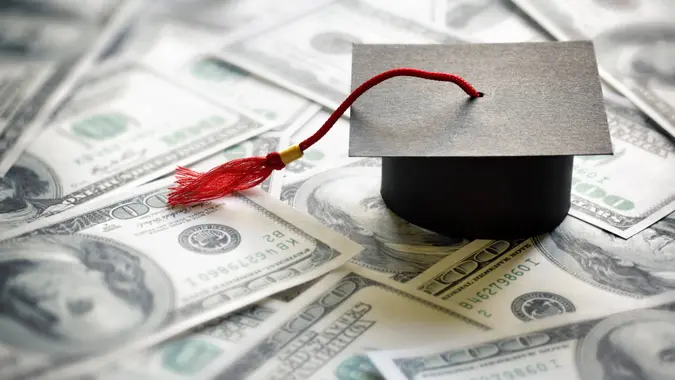How Much Down Payment for a Car Is Enough? A Quick Guide

Commitment to Our Readers
GOBankingRates' editorial team is committed to bringing you unbiased reviews and information. We use data-driven methodologies to evaluate financial products and services - our reviews and ratings are not influenced by advertisers. You can read more about our editorial guidelines and our products and services review methodology.

20 Years
Helping You Live Richer

Reviewed
by Experts

Trusted by
Millions of Readers
When financing a new or used vehicle, making a down payment is a wise move. Putting money toward your loan up front helps build equity more quickly and results in less interest and lower payments.
Here’s more on how much you should put down on a car, the benefits of making a larger down payment and tips for saving up.
How Much Down Payment for a Car Is Recommended?
The recommended down payment is 20% for a new car and 10% for a used car. If you’re leasing, your down payment can range from $0 to $3,000, depending on the lease terms.
For example:
- New car: 20% down — a $55,000 car would require a $11,000 down payment.
- Used car: 10% down — a $25,000 car would require $2,500.
- Leased car: $0-$3,000 down depending on credit and lease structure.
What’s the Minimum Down Payment for a Car Loan?
Most lenders don’t require a specific minimum down payment amount for a car loan, and some will allow 0% down. Whether or not you’ll have to make a down payment depends on a combination of factors including the following:
- The price of the vehicle
- Whether the vehicle is new or used
- Your credit score
Your credit scores affect your loan terms, monthly payment and how much interest you’ll pay.
- Higher scores usually mean better rates, smaller payments and no required down payments.
- If your credit is poor — under 600 — you may need to put more money down to get approved, and lenders might require it to reduce their risk.
Overall, the more you can afford to put down, the better, because it will reduce the overall cost of the loan, which will help you save.
Benefits of Making a Larger Down Payment
A larger down payment can help you save in several ways.
- Lower monthly payments: When you make a big down payment, the balance of the loan is significantly reduced, which means you’ll have lower monthly payments.
- More favorable loan terms: Making a higher down payment and reducing the size of the loan you need may also mean a lower interest rate because it lessens the lender’s risk.
- Less interest: The smaller the loan, the less time you’ll have to spend paying it. Less time paying a loan equals less interest.
- Less chance of negative equity: A larger down payment also means that you’ll build equity more quickly, which lessens the chance that you’ll owe more on the car than it’s worth as it depreciates.
How To Save for a Car Down Payment
There’s no strict rule for how much you must put down — 10% for used cars and 20% for new ones are just general guidelines. If you have strong credit, you might qualify with less. But the more you put down, the more you can save in the long run.
Here are a few ways to start setting money aside:
Set a Savings Goal
Determine how much money you’ll need to save based on the vehicle’s price.
Use an online auto calculator that includes a down payment option to estimate costs. You can test out down payments of varying amounts to see how it would affect the length of the loan and the monthly payment amounts.
Cut Unnecessary Expenses
Think about where you can reduce your nonessential spending each month, such as cancelling subscriptions you don’t use or skipping an expensive daily habit, and put the money toward your savings goal.
Also, open a dedicated savings account to keep the funds separate from your regular spending and to make your savings goal easier to track.
For effortless saving, consider setting up automatic transfers to the account each time you get paid.
Explore Additional Funding Options
Another way to make a down payment is by trading another vehicle you own that’s either paid off or has equity. The trade-in value will count toward the down payment.
You potentially could get more money for a down payment by selling your vehicle outright than trading it due to cutting out the middleman. However, it will take more time to sell your vehicle rather than trade it.
Pro Tip
Use windfalls like tax refunds or work bonuses to boost your down payment savings. Even small amounts from a side hustle can add up quickly when set aside just for your car fund.
Example Car Down Payments and Monthly Costs
When you finance a car, your down payment size can significantly impact your monthly payment and the total interest you pay.
Below are example scenarios for new car purchases financed over 60 months at a 6.69% APR. Each example compares a 10% vs. 20% down payment. These estimates exclude tax, title, registration and fees.
| Car Price | 10% Down Payment | 20% Down Payment | Estimated Monthly Payment | Interest |
|---|---|---|---|---|
| $35,000 | $3,500 | $7,000 | 10%: $619.14 20%: $550.35 |
10%: $5,648.45 20%: $5,020.85 |
| $45,000 | $4,500 | $9,000 | 10%: $796.04 20%: $707.59 |
10%: $7,262.30 20%: $6,455.38 |
| $55,000 | $5,500 | $11,000 | 10%: $972.94 20%: $864.83 |
10%: $8,876.14 20%: $7,889.90 |
Think Twice Before Putting 0% Down
Although putting 0% down on a car helps keep more cash in your pocket, it’s not a wise financial decision unless the vehicle you’re financing has 0% or very low interest. Opting to forgo a down payment means a higher loan balance, larger monthly payments and more interest paid over the life of the loan.
Instead, use an auto loan calculator to work out a down payment amount that works well for you. Remember: the larger the down payment, the more you’ll save.
FAQ
Here are the answers to some of the most frequently asked questions regarding vehicle down payments.- What's the average down payment for a car?
- The rule of thumb for vehicle down payments is 20% for new cars and 10% for used.
- Can I buy a car with no down payment?
- Most car dealers don't require a down payment unless your credit is poor. However, a down payment can decrease the balance of your loan, which may result in better terms and less interest paid over the life of the loan.
- Does a higher down payment help you get approved for a loan?
- If your credit is under 600, a higher down payment may help you get approved for a loan.
- How does a down payment affect interest rates?
- A down payment can reduce the amount of the loan, and a smaller loan poses less of a risk to the lender, which may result in a lower interest rate.
- Should I put more money down on a used car vs. a new car?
- No, it's the opposite. The rule of thumb is 10% down on a used car versus 20% for a new car.
Our in-house research team and on-site financial experts work together to create content that’s accurate, impartial, and up to date. We fact-check every single statistic, quote and fact using trusted primary resources to make sure the information we provide is correct. You can learn more about GOBankingRates’ processes and standards in our editorial policy.
- The Zebra. 2024. "Should I trade in my car or sell it myself?"
- Experian. 2024. "How Much Is a Down Payment on a Car?"
- Equifax. "How Much Should My Car Down Payment Be?"
- Car and Driver. 2022. "What's the Lowest Down Payment for a Car?"
- Progressive. "How much should you put down on a car?"
 Written by
Written by  Edited by
Edited by 






















